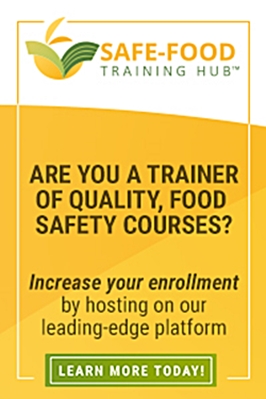Category archive for ‘Food Safety’
Waterless Process Decontaminates and Extends Shelf Life of Produce
By Paul Moyer A few years ago, a Listeria outbreak linked to caramel apples triggered considerable concern in North America over the challenges of keeping produce safe for consumers. Although Moyers Apple Products wasn’t involved in the outbreak, we began developing a waterless process to clean fresh fruits and vegetables, and our efforts recently earned […]
High-Quality Traceability Key to Global Food Safety
By John Keogh Earlier this year, the Federal Department of Agriculture (FDA) released a statement about the agency’s investigation of the November 2018 outbreak of E. coli O157:H7 in relation to contaminated romaine lettuce in California raising some interesting points. The FDA announcement essentially confirms what many of us have had suspicions about, and again confirms why […]
Japan’s Food Safety Systems Get Global Recognition
By Lois Harris Pulling together a globally-recognized food safety certification system in a nation in which the vast majority of traditional food manufacturers are small and medium-sized enterprises (SMEs) seems like a nearly impossible task. But Japan has done it. In late 2018, the Japan Food Safety Management Association and the Japan GAP Foundation received […]
Preparing for the Worst: Risk Assessments and Why They’re Needed
By Margaret Balfour While the concept of HACCP-based risk assessments for food safety (chemical, biological and physical) has been very well established globally, much of the food industry has yet to come to terms with the development of risk assessments focusing on vulnerability, authenticity and threats. To further complicate matters, multiple terms are used globally […]
Blockchain Poised to Boost Efficiency for Food Manufacturers
By Tomaž Levak The blockchain and distributed ledger technologies (DLT) have come a long way in the past year. The hype that was largely connected with the Bitcoin cryptocurrency has slowed down, but innovation on the enterprise side is stronger than ever. In the past year, a number of pilot projects were successfully launched across […]
Enhanced Food Safety Training Key to Compliance
By Tina Brillinger With new food safety regulations rolling out in Canada on the heels of the new American legislation it’s important that businesses know what’s changed, and what employees need to be doing differently, in order to meet compliance. So, it’s no surprise that one of the biggest trends in the industry is ensuring that proper food […]
Climate Change Plans will Prevent Food Safety Issues
By Suzanne Osborne The Food and Agriculture Organization of the United Nations (FAO) has, for years, warned that climate change is going to have dramatic effects on food businesses going forward. A record drought in Texas in 2011 cost the agricultural sector $7.6 billion and similar drought conditions have more recently led to the complete […]
Early BPA Study Results Say It’s Safe, But Does It Matter?
By Suzanne Osborne Just about everyone in North America has Bisphenol A (BPA) in their body right now. Should manufacturers be concerned about consumer backlash to the packaging practices that may have contributed to the issue? BPA is used to manufacture plastic food containers (baby bottles, tableware, reusable beverage bottles). Small amounts of BPA can […]
New Safety Requirements on the Way for Canadian Food Importers
By Tammy Switucha Canada is recognized as having one of the strongest food safety systems in the world. But the speed, volume and complexity of food production have produced new risks and challenges. Significant changes in production and distribution environments have resulted in elaborate and extensive global supply chains that support increased consumer demand for […]
Rising Food Safety Demands: Tips to Build Efficiency Into Your Operation
By Joan Martino The landscape for food producers is continuously more challenging with increased demands from every direction: new regulations, greater enforcement from government and third-party auditors, the cost of obtaining recognized certifications, licensing, and more. And how do these demands for more enhanced food safety translate into the day-to-day business? Increased costs and lower margins. Why, […]


